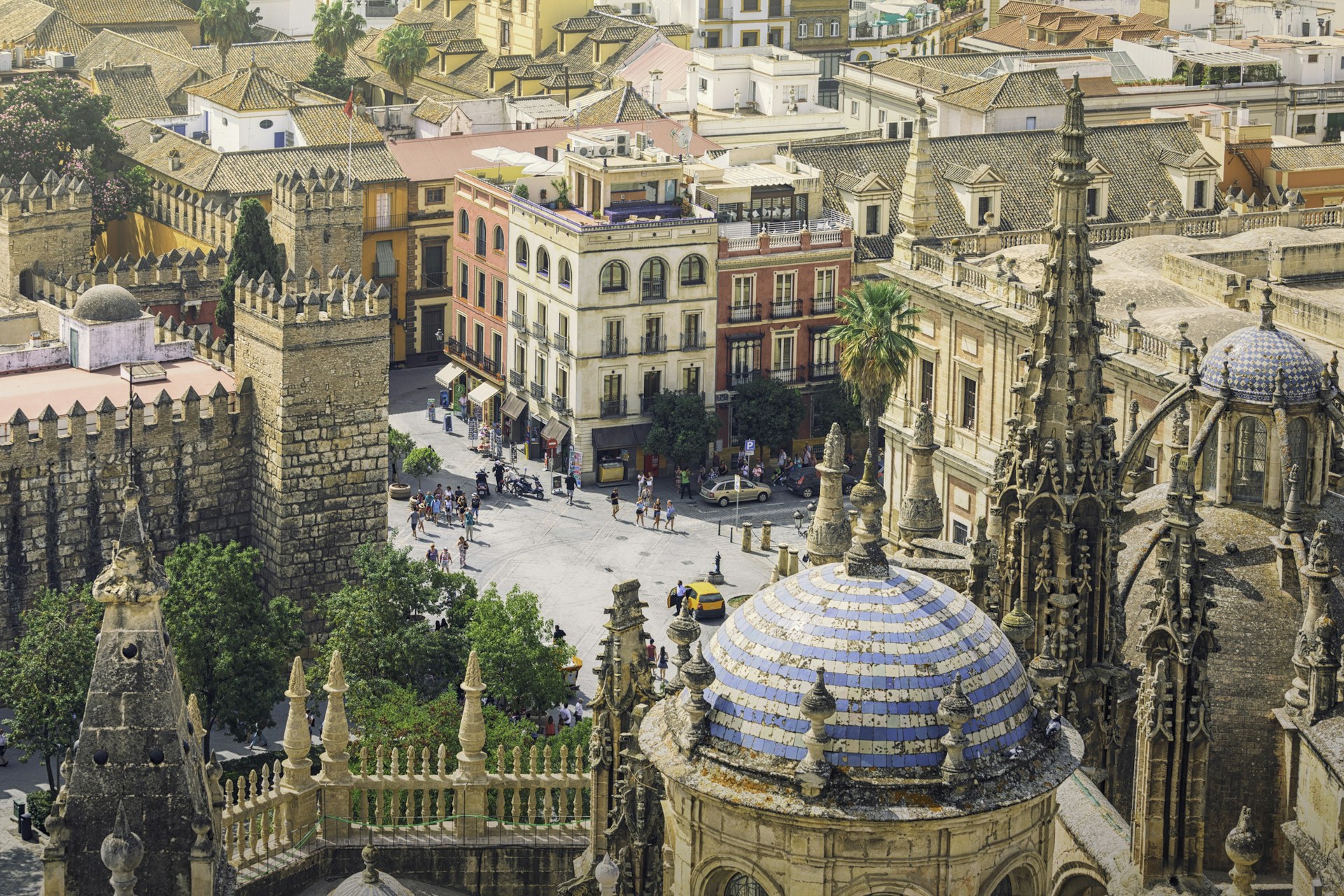Many civilizations have left their mark on Seville.
The capital of Andalucía is proud, beautiful and packed full of culture. It wears its heritage with pride, and the sensual blend of Islamic, Gothic and Renaissance architecture is on magnificent display in the royal palace and mighty cathedral.
Beyond the elaborate mansions and verdant parks that Seville is most famous for, the city’s spirit thrives in countless tapas restaurants in bar-strewn plazas and along the banks of the Guadalquivir river. From soul-stirring flamenco to glorious gastronomy and gregarious neighborhoods, here are our favorite things to do in Seville.
1. Marvel at the Real Alcazár
Remarkably well-preserved, the royal palace is one of Spain’s most beautiful buildings and serves as a palimpsest of Sevillian history. Originally built as a fort in the 10th century, subsequent rulers – from the Moors of North Africa to the Spanish Christians six centuries later – left their indelible mark on the palace complex.
Let your imagination run amok beneath intricately carved archways and in staterooms whose geometric tiles have witnessed the scheming of sultans and kings. Don’t miss the stunning Patio de las Doncellas, which archaeologists uncovered in 2004, or the subterranean baths of Doña María de Padilla. The sensual, foliage-filled gardens look prettiest in the soft light of the late afternoon – keep an eye out for a glimpse of peacock feathers.
Planning tip: Long entry queues are standard here. To cut waiting time, buy tickets online in advance.
2. Tour the rooftop of the largest Gothic cathedral in the world…
The Catedral de Santa María de la Sede is a staggering affair that melds Gothic, Renaissance and Moorish architecture. In true Sevillian style, Spanish Christians transformed the city’s 12th-century mosque into a cathedral between the 15th and 16th centuries. These layers of history are best viewed on a rooftop tour, where you can get up close with startling gargoyles and intricate stained glass windows, and even see the sculptors’ initials etched into the stonework.
If you can bear the crowds of tourists traipsing through it, make time for the cathedral’s cavernous interior, home to Christopher Colombus’ tomb and several valuable works of art. Ogle Francisco de Goya’s haunting painting Santas Justa y Rufina, the martyrs who are the city’s patron saints, before stepping out into the peaceful Patio de los Naranjos, an inner courtyard named after the 66 orange trees within.
3. …and then climb the Giralda for unbeatable views of Seville
An icon of Seville’s elegant skyline, the Giralda – the bell tower of the cathedral – gleams golden against the blue sky that stretches above Andalucía nearly all year round. The scalloped archways and Islamic ornament found on the lower section belies the Giralda’s origins; it was formerly the minaret of the 12th-century mosque.
Planning tip: Climb the 35 ramps and flight of stairs during the morning while it is cool. It’s worth the effort; at the top lie 24 mighty bells and panoramic views of Seville, with the hazy outline of the Sierra Norte mountains in the distance.
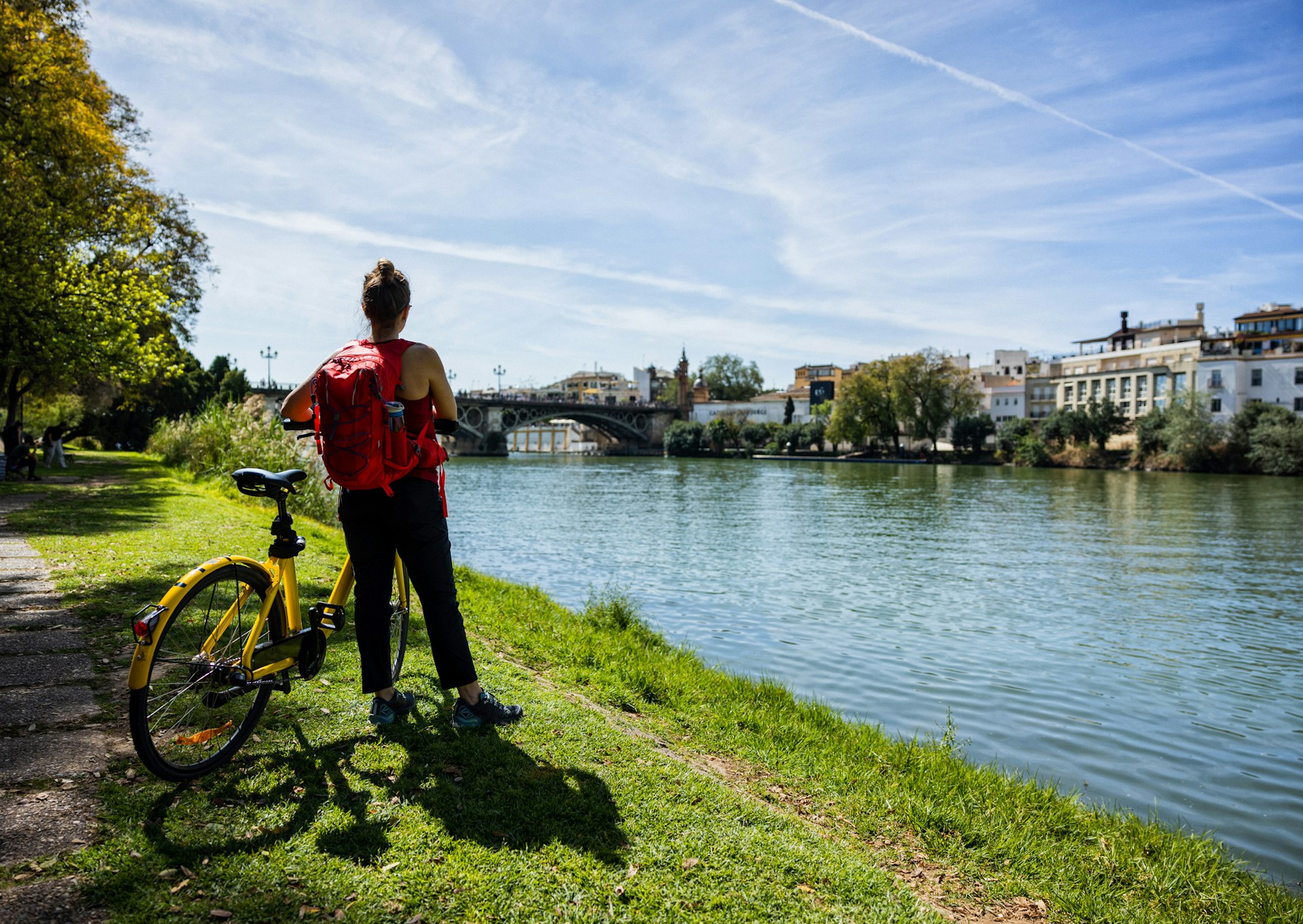
4. Hire a bike and cycle around Seville
Flat and sunny Seville is one of Spain’s most cycle-friendly cities. Grab a pay-as-you-go bicycle, Servici, and head off along 180km (111 miles) of smooth, interconnected bike lanes. Set out from the old Jewish district of Santa Cruz, a labyrinth of cobbled streets and squares shaded by orange trees, then head north towards the La Macarena neighborhood. En route, you’ll pass the ochre-and-white Basílica de La Macarena and the soaring arches of the Palacio do los Marqueses de la Algaba, a restored Mudéjar palace that doubles as a cultural center.
After refueling on café con leche, pedal south past the two-millennia-old Roman columns on Alameda de Hércules square and over the river into Triana. The heart of Seville’s old ceramics industry is less picturesque than Seville’s other neighborhoods but still worth a visit. It is lined with popular cafes, and eye-catching tiles adorn shop fronts, though not much happens here during siesta hours.
5. Clap along to an entrancing flamenco show
Raw, passionate and utterly hypnotic, flamenco in Seville is rooted in Triana. This typically working-class neighborhood was originally home to the Roma community, people who migrated from eastern Europe in the 15th and 16th centuries. Intimate flamenco shows at night are the most powerful; let the frenzy of stamping feet and quavering voices transport you in Triana’s CasaLa Teatro.
Close to the cathedral, shows in La Casa del Flamenco unfold between Mudéjar arches or for something simpler, try the tiny La Casa de la Guitarra. With its low-slung ceilings, wooden beams and program of top-quality artists, atmospheric El Arenal hosts one of the best tablaos of flamenco in the city. For more of a casual setting, try Lola de los Reyes, an authentically Sevillian bar whose elegant proprietor frequently joins in. You will need to spend around €10 on copas.
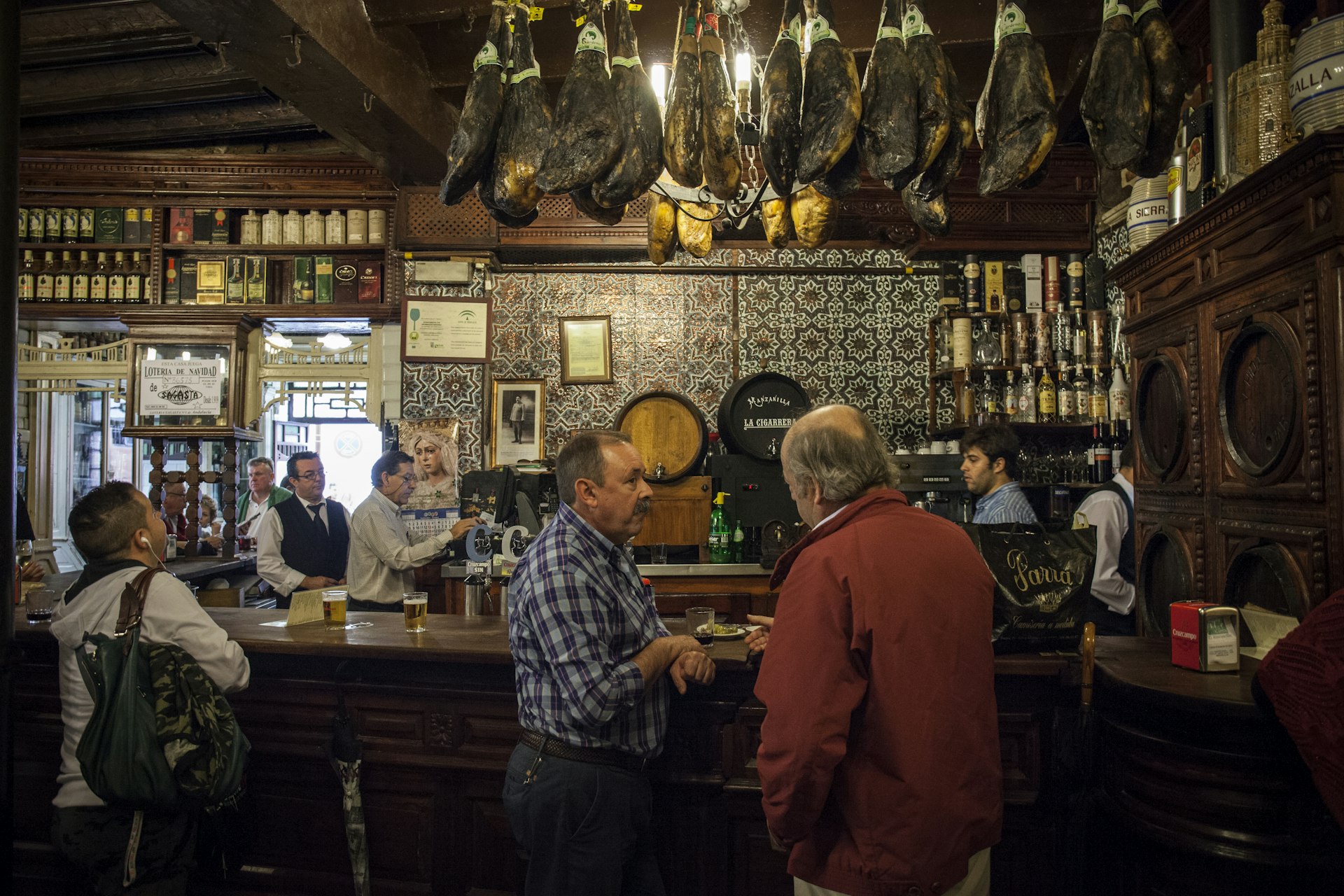
6. Feast on tapas in Seville’s best restaurants
Seville is truly the epicenter of tapas – the small plates that have become one of Spain’s most prolific exports. More than 3000 tapas bars hide along Seville’s side streets. Some are traditional affairs of wood and tiles in an old bar; others are swankier fusion joints.
Feast on Andalucían classics such as pescaítos fritos (deep-fried fish) or artichokes with jamón at Casa Morales. Stand with the locals at the back of this bustling bodega, a jarra of local brew Cruzcampo in hand. Just around the corner, haunches of ham swing from the ceiling of Cafe Bar Las Teresas, a friendly tapas bar packed with loyal customers.
If you should tire of the platters piled high with fried slivers of berejenas (aubergines) and casseroles of chickpeas and spinach, then make your way to La Brunilda, an unassuming whitewashed building where inventive cuisine is beautifully served. Locals may squabble over who serves the best acorn-fed jamón ibericó bellota in Seville, but everyone agrees that the wafer-thin slices of the cured, salty meat are delectable at Casa Román, a 19th-century institution on the Plaza Venerables. Pencil in time for a siesta after lunch.
7. Paddleboard along the Guadalquivir River
When Ferdinand Magellan set out to circumnavigate the globe for the first time in 1519, he struck out from the Guadalquivir River. The blue ribbon that slices twice through Seville was essential to the riches of the Spanish Empire, built up over centuries of maritime trading.
For a slightly more unusual view of the city, take a leisurely paddle down the river with a slight breeze in your hair. Glide beneath the decorative bridges that connect Seville’s two banks – Puente de Isabel II is the oldest – and past prettily-painted apartments that stand proudly at the water’s edge.
Planning tip: The helpful guides at Paddle Surf Sevilla give tours of the city’s history as you float along. It is surprisingly social on the river; time it right, and you may cross paths with Seville’s devoted flotilla of rowers and kayakers.
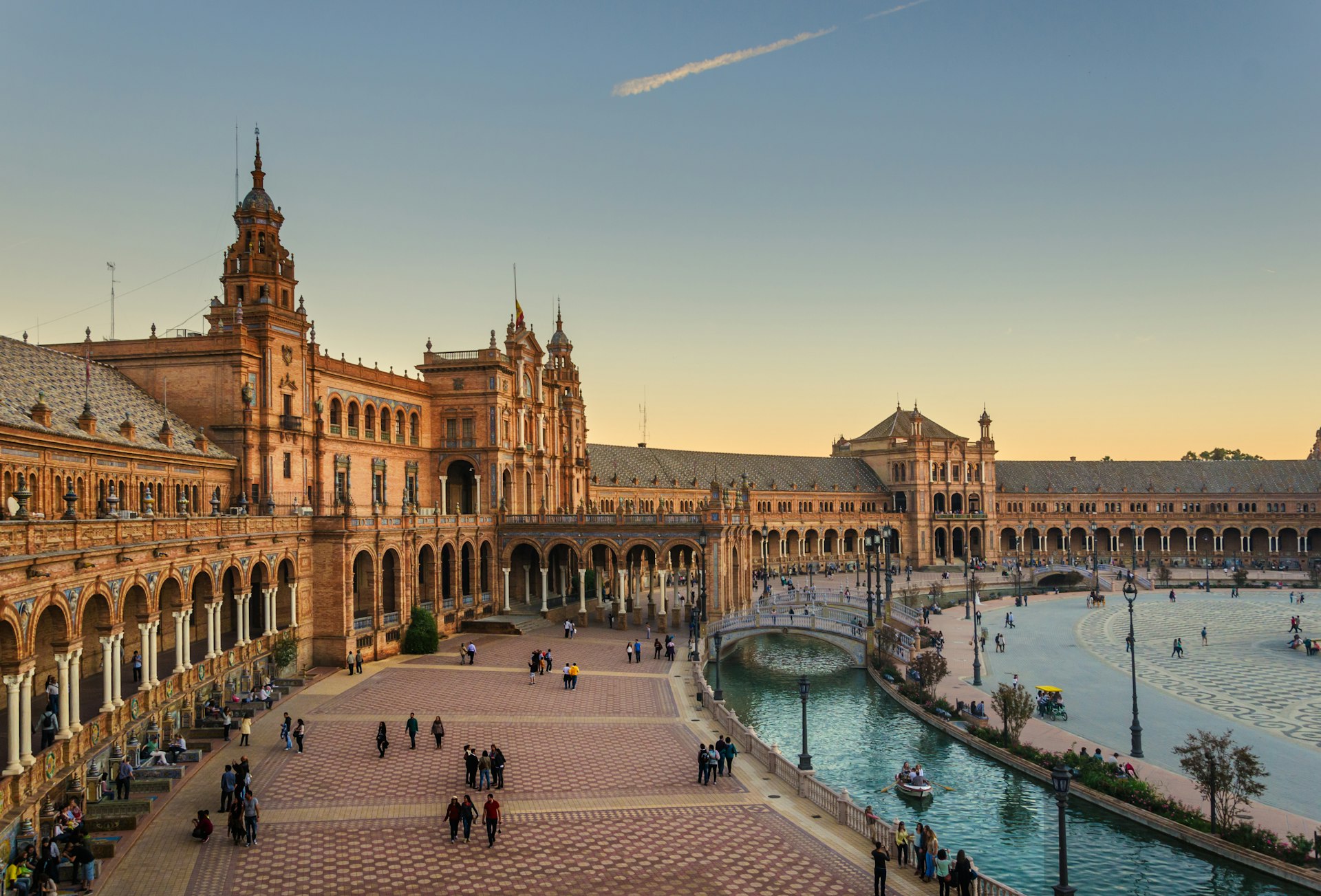
8. Learn about Spanish history at Plaza de España
Glorious and sun-drenched, this grand monument to Spain’s historic towns and cities is crammed full of the azulejo tiles that Seville is famous for. An ambitious commission for the 1929 Exposición Iberoamericana, it took local architect Aníbal González 15 years to complete the Plaza de España. Each of the four bridges over the crescent-shaped canal represents the old kingdom of Spain: Castile, León, Navarre and Aragón. Between snapping pictures, brush up on your Spanish history; tiled murals in each alcove tell the story of Spain’s provinces.
Planning tip: Visit during the quiet of siesta while the rest of the city naps.
9. Sample sherry from Andalucía’s best wineries
In Seville, sherry is not a dusty bottle at the back of the drinks cabinet. The city sits just north of southern Spain’s “sherry triangle,” meaning bars throughout the city stock superb wines from artisan producers. Forget the sickly sweet tipple that gets rolled out at Christmas; these drinks are dry, delicate and quaffable. The paler-colored Manzanilla, Fino and Amontillado styles are tangy and aromatic. Fuller-bodied Oloroso varieties taste great with meat dishes.
Mixologists shake bold, sherry-based concoctions at late-night spot Premier Sherry Cocktail Bar in the old town. With more than 60 sherries to choose from at Palo Cortao, this swish tapas bar tucked down a tiny side street is where to linger over a glass, or three.
Planning tip: Pick up a bottle to take home at Flores Gourmet, a specialty abacería (shop) that sells only local produce.
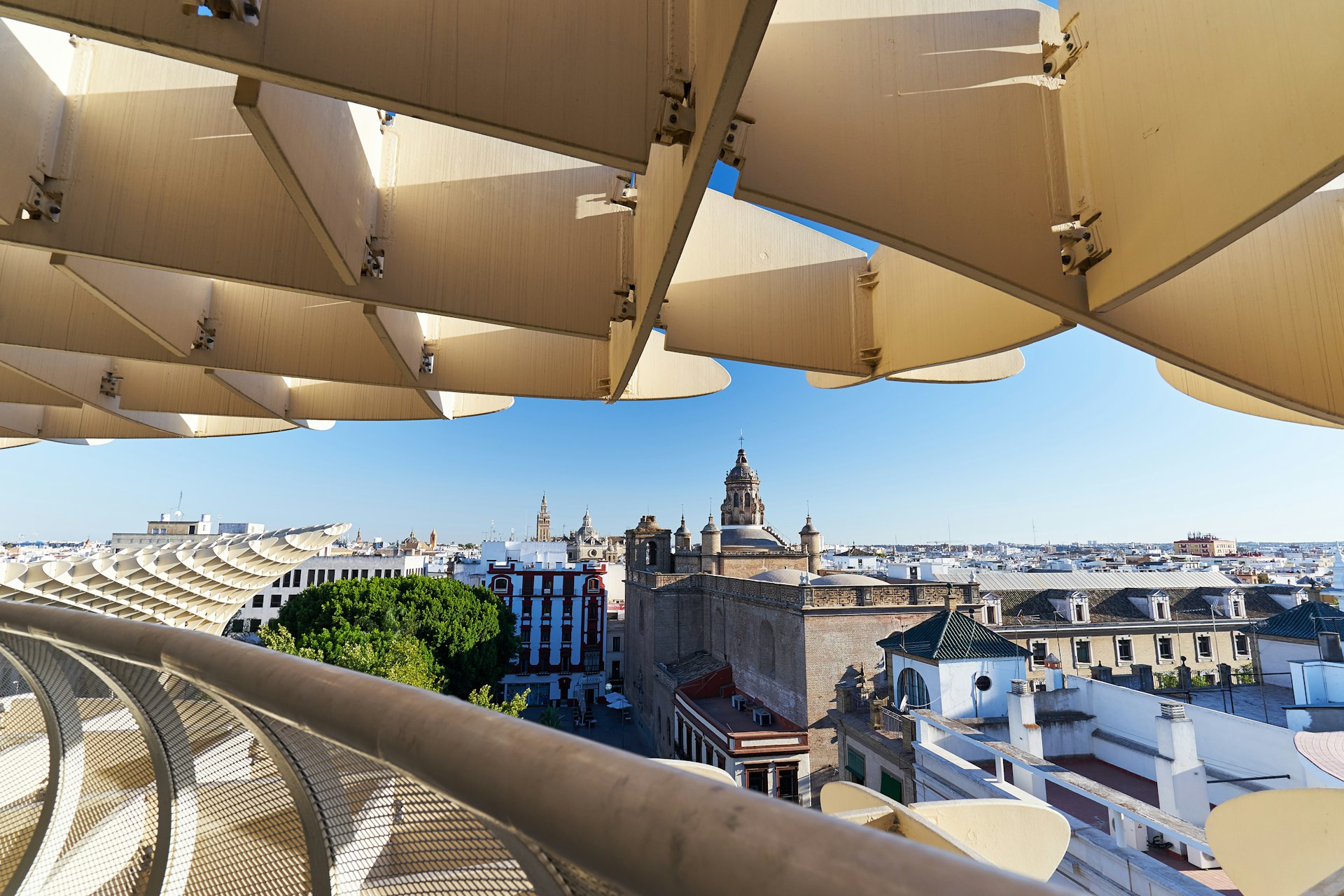
10. Ascend the Metropol Parasol
Las Setas (mushrooms), as the Metropol Parasol is locally known, acts as a contemporary counterbalance to Seville’s centuries-old architecture. There are no Gothic archways here; instead, a showy, modernist structure built entirely from wood – one of the largest in the world – sits atop a Roman and Moorish archaeological site.
Planning tip: Meander through the vast cuboid structure via rooftop walkways at sunset, when the futuristic timber lattice is lit up, before settling down to sip a caña in the Plaza de la Encarnación, a buzzy former market square.
11. Cool down in Seville’s parks
When the temperatures soar, seek shade in any of Seville’s nine green spaces. The Parque de Maria Luisa is a spectacular spot for a Sunday stroll. A small pavilion overlooks the aqua lagoon, and the sound of horse hooves rings out between the secluded walkways dripping with flowers. Ancient trees and colorful blooms dominate the Murillo gardens, tucked behind the Alcázar.
12. Enjoy a tipple at a majestic hotel
With its tiled turrets and towering palm trees, it is easy to mistake the Hotel Alfonso XIII for the royal palace. In fact, the eponymous king demanded that the hotel be built to welcome presidents and distinguished guests during the world’s fair that bequeathed Seville with so many monuments. The grandeur remains to this day.
Planning tip: Quench your thirst with mint tea or something stronger inside the exquisitely decorated inner courtyard – a homage to Andalucían crafts and timeless elegance. The rest of the hotel is equally decadent.

13. Time your visit to coincide with a festival of Sevillian culture
Accommodation costs will hike up during Seville’s annual Feria de Abril, though the ebullient, sherry-fuelled week is still worth dipping into. The festival is one of Andalucía’s most important, and Sevillanas stroll the calles (streets) in traditional dress or mounted on horseback.
In July, the revelry returns to Triana for its own 400-year-old festival. During festivals, much of the entertainment takes place outdoors, free of charge. Visit Seville during the biennial of flamenco to witness the frenzied art form at its spine-tingling best. This is when the streets come alive with maestros and baillarinas stamping their feet and whirling shawls as mournful seguiriyas fill the air.
14. Unwind in the Arab baths
After the glare of Seville’s sunny squares, the candle-lit depths of the Arab baths offer instant respite. Like much of the city’s architecture, the act of communal bathing harks back 700 or so years to when Seville was the seat of Moorish power. Then Muslims would cleanse by moving through a series of marble pools before seeking purification of the spiritual sort in a nearby mosque.
Today, the experience is less authentic but no less pleasurable. The ritual of steam, scrub and soak is heavenly at Aire Baños Árabes – spa baths housed inside a grand 16th-century Mudéjar palace. After floating through the thermal circuit beneath cavernous ceilings bedecked with bronze lanterns, head up to the roof terrace for a view over the medieval cathedral and bell tower.
Planning tip: This is one of Seville’s most romantic activities; reserve a slot at dusk before a late-night meal.
15. Revel in Spanish Golden Age art
The Museo de Bellas Artes, situated in a former convent, crams in work by Spain’s most notable painters – who also happen to be Sevillian: Diego Velázquez, a bronze statue of whom also gazes out over the Plaza del Duque; and Bartolomé Esteban Murillo, a baroque artist whose gentle, religious scenes also adorn the chapel of the striking Hospital de la Caridad. Sala (room) V, a former church, is a fitting place for Murillo’s The Immaculate Conception. Raised on high beneath the gold-flecked cupola, the radiant painting of the Virgin Mary adds a touch of the divine.
16. Admire the tiles in Casa de Pilatos
The Casa de Pilatos was the formal residence of the aristocratic Medinaceli family, and some find this petite palace even more splendid than the Alcázar. Inside, stuccoed arches frame a graceful patio, and geometric patterns run wild over the tiled, 16th-century walls. Perfectly pruned Sevillian orange trees stand to attention over another courtyard and on the ground floor; the soft tinkling of a fountain is always audible. Spot busts of Roman emperors and Greek heroes throughout the Mudéjar mansion – a nod to the Italian Renaissance.
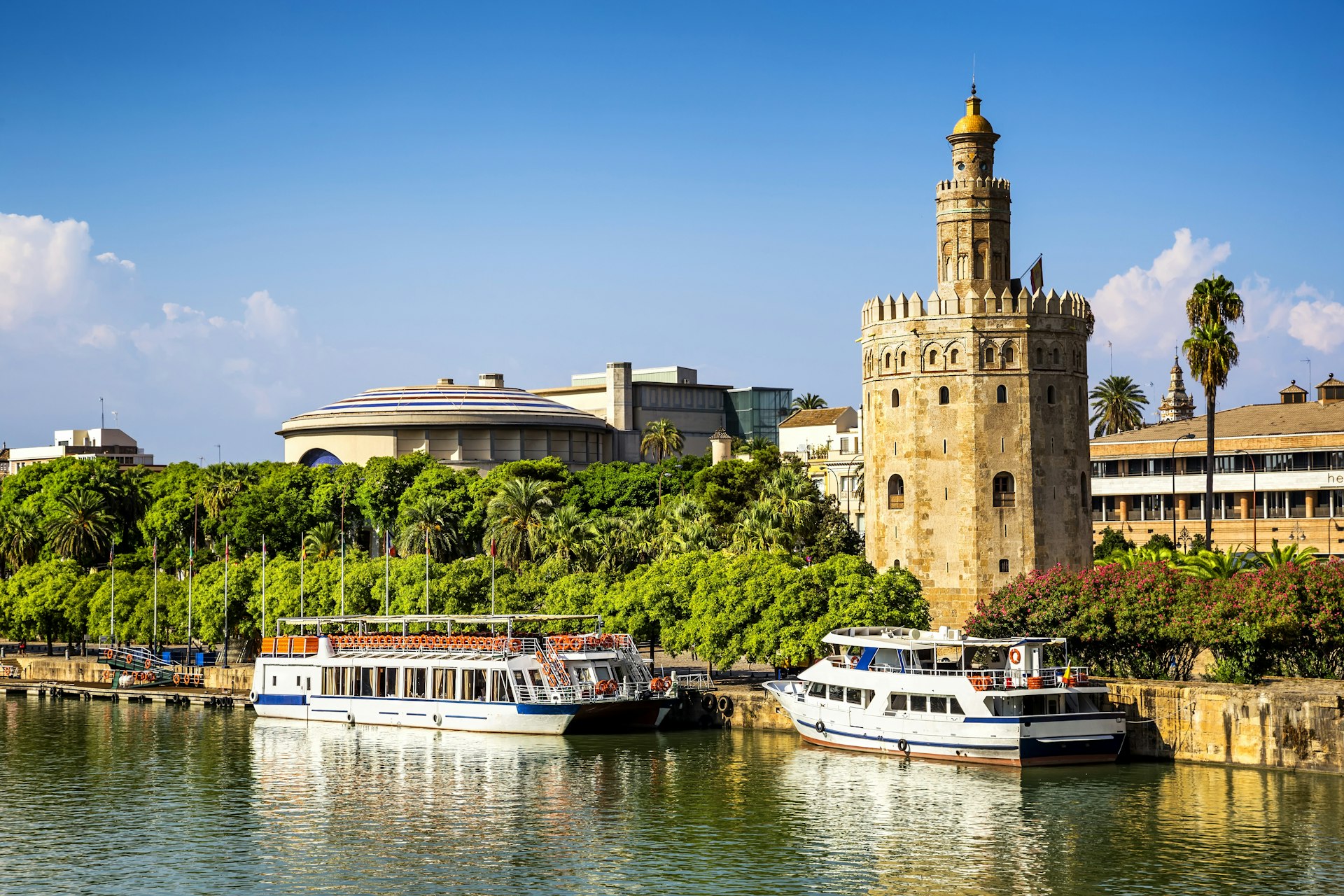
17. Play at the beach, then take a riverside stroll
Life around the Guadalquivir River is more placid now than when this was the major artery of trade for the Spanish Empire. Ponder the river that earned the Catholic Monarchs of Spain their war chest from the artificial sandy beach at Muelle de las Delicias, complete with volleyball nets and sun loungers, then stroll north along the bank, past the imposing Torre del Oro watchtower to the old fish market for a drink. The smartly-restored Mercado Lonja del Barranco is a magnet for foodies.
18. Meander around Triana
It’s hard not to imagine the former inhabitants of this bohemian barrio: the Roma gypsy community, religious deviants and the sailors who joined Christopher Columbus on his voyage to the Americas.
Inside the Centro Cerámica Triana, gaze at the azulejo tiles which served as the neighborhood’s lifeblood until the mid-1960s, then walk a few miles along the ruta de la cerámica. Head north from the Punta de Isabel II bridge, past the blue and yellow dome of the Capilla Virgen del Carmen and along the Calle Castilla, before looping back down Calle Alfarería towards Plaza del Altozano. Peep through the gateway of the flower-filled Casa de las Flores, one of the few attractive surviving multi-family workers’ houses in Seville, then stop at Cerámica Santa Ana to pick up gifts. Finish up at any of Triana’s lively bars for a night on the tiles.
19. Discover Seville’s Roman history
Centuries before Seville became the capital of Muslim Spain, the Romans ruled the city here called Hispalis. Evidence of the 2000-year-old town sits in the Calle Mármoles, where three of six towering granite columns, most likely the remains of a temple, stand frozen in time as nature grows around them. A pair were moved to the Alameda de Hércules square in the 16th century; the other was broken in transit.
Planning tip: The Roman mosaics in the courtyard of the resplendent Palacio de la Condesa de Lebrija have fared better. Explore the palace house’s remarkable collection of Roman artifacts for free on Fridays at 10am.
20. Tour Spain’s most important bullring
Though many people fundamentally disagree with blood sports for reasons of animal cruelty, bullfighting is woven deeply into the fabric of Andalucía, as any Sevillano will tell you. This quintessentially Spanish tradition is protected by the EU. If you’d like to learn more, take a guided tour around La Maestranza. A small exhibition explains the history of the plaza del toros (bullring) and how the heart-stopping la fiesta brava works.
Planning tip: Entry is free from 5:30 to 7:30pm on Wednesdays.
